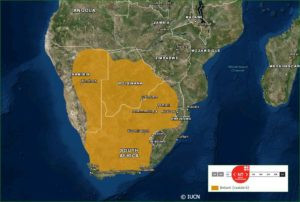The Black-footed Cat (Felis nigripes) holds the title of Africa’s smallest feline and ranks among the world’s smallest wild cat species. Don’t let their diminutive size fool you; these creatures are known for their fierce spirit and hunting prowess.
Characterized by their soft, dense fur, Black-footed Cats exhibit a coat color ranging from dark to pale tawny gold. A striking pattern of bold, rounded dark brown to black spots adorns their fur, sometimes coalescing into bands or rings. Their eyes, large and expressive, are amber or greyish-brown, adding to their captivating appearance. The underside of these cats, including the chin, chest, belly, and inner legs, is whitish, contrasting with the pale brown backs of their ears. Distinct dark streaks mark each cheek, and dark bars decorate their forelegs and haunches. Their relatively short tail, approximately half their body length, features two or three black rings and tapers to a black tip. Remarkably adapted to their arid desert environment, Black-footed Cats possess a broad skull and large, rounded ears. These oversized ears are not just for show; they provide exceptional hearing, crucial for detecting scarce prey in their habitat. Interestingly, they flatten their low-set ears completely in an ‘aggressive’ posture, a unique adaptation for hunting in areas with minimal cover. Further showcasing their desert adaptations, they have hair on the black soles of their feet, providing insulation and protection from scorching sand.
Distribution and Habitat
 Black-footed cat range map showcasing distribution across Southern Africa
Black-footed cat range map showcasing distribution across Southern Africa
Black-footed Cats have a restricted distribution, found exclusively in three Southern African countries: Botswana, Namibia, and South Africa. Their preferred habitats are short to medium length grass plains, scrub desert, and sand plains, notably including the Kalahari and Karoo Deserts. Areas characterized by grasses with high populations of rodents and birds are considered optimal habitat for these felines. They tend to avoid densely vegetated or rocky terrains, possibly due to the presence of larger carnivores. The regions they inhabit receive an average annual rainfall of 100-500 mm.
Compared to other small cat species in Southern Africa, the Black-footed Cat is considered rare. Much of our understanding of their behavior and ecology stems from a long-term study conducted over decades at the Benfontein Nature Reserve and two extensive farms in central South Africa. Researchers from the Black-footed Cat Working Group continue their dedicated research in these areas, furthering our knowledge of this elusive species.
Within a 60 sq km study area, researchers documented an adult cat density of 0.17 per sq km. However, densities are significantly lower in less favorable habitats. Males exhibit larger home ranges, averaging 20.7 sq km, compared to females, whose ranges average 10 sq km. Male territories often overlap with those of one to four females.
Ecological Role and Hunting Prowess
Known for their incredible tenacity, local folklore includes legends of these tiny cats capable of taking down a giraffe. While this is a myth, it speaks volumes about the perceived fierceness and determination of these small felines.
A comprehensive study in South Africa analyzing the diet of Black-footed Cats revealed an impressive 1725 prey items consumed. Males were observed to take larger prey species compared to females. Mammals constituted the majority of their diet (72%), followed by small birds. Invertebrates, amphibians, and reptiles were consumed infrequently. Small rodents, particularly the large-eared mouse, are especially crucial during the reproductive season for females raising kittens. Males exhibit less seasonal variation in prey selection, potentially minimizing competition between sexes.
Black-footed Cats share their habitat with a variety of other carnivores, including the African wildcat, Cape foxes, bat-eared foxes, and black-backed jackals. They typically prey on smaller animals compared to African Wildcats (Felis silvestris lybica), although both species capture a similar number of prey items per night (approximately 12-13). To coexist with jackals, which are potential predators, Black-footed Cats utilize burrows for daytime shelter. While they share territory with Cape foxes, they minimize competition by utilizing different habitats, activity patterns, and prey species.
Remarkably, a single Black-footed Cat can consume up to 3,000 rodents annually, highlighting their significant role in rodent population control. They have also been observed scavenging on dead springbok lambs, although they do not actively hunt them. Larger males are capable of taking down adult Cape hares, which can weigh approximately the same as the cat itself. They also consume eggs, employing a delicate technique of gently crushing them between their jaws and licking the contents clean. Although they primarily obtain their hydration needs from their prey, they will readily drink water if available.
During the heat of the day, Black-footed Cats seek shelter in abandoned termite mounds or burrows. In South Africa, 98% of 184 recorded resting sites were abandoned springhare burrows. Their habit of resting in termite mounds has earned them the local name ‘anthill tiger’. Their nocturnal activity is closely tied to the length of the night, typically leaving and returning to their dens within 30 minutes of sunset and sunrise. Their hunting strategies include patiently waiting near rodent burrows for up to 40 minutes or flushing out nesting birds by rapidly moving through the grass. Interestingly, marsh owls have been observed shadowing hunting Black-footed Cats, taking advantage of flushed prey.
While primarily terrestrial hunters, they are adept climbers, frequently ascending trees and fence posts to search for bird nests. However, acacia trees in their habitat generally offer less food compared to the ground level. When attempting to catch flying birds, they exhibit impressive agility, making frequent jumps of up to 2 meters in distance and 1.5 meters in height.
Researchers once witnessed a male Black-footed Cat boldly stealing a gerbil from a striped polecat, another tenacious member of the weasel family, demonstrating their fearlessness even towards other predators. On several occasions, black-backed jackals have been observed cornering Black-footed Cats. In each instance, the tiny cat aggressively attacked, successfully driving away the much larger jackal, showcasing their incredible courage and defensive capabilities.
Reproduction and Life Cycle
Black-footed Cats are solitary animals, except for females raising dependent kittens and during mating periods. Following a gestation period of 63-68 days, females give birth to litters of one to four kittens, typically at the bottom of a burrow. Newborn kittens weigh a mere 60-84 grams. Females can have up to two litters per year. Mothers frequently relocate dens, likely as a strategy to avoid attracting predators to their vulnerable young. Kittens’ eyes open around seven days old. They achieve independence at 3-4 months but often remain within their mother’s territory for an extended period. Remarkably, they begin hunting at a very young age, reflecting the demands of survival in their harsh environment. When a mother cat issues an alarm call, the young kittens instinctively scatter and freeze, remaining motionless until the perceived danger has passed.
Conservation Status and Threats
The Black-footed Cat faces a number of human-induced threats that impact their populations. Overgrazing by livestock is widespread across their range, leading to habitat degradation and a decline in their prey base. Indiscriminate poisoning of carcasses, intended to eliminate Caracals (Caracal caracal) and jackals, poses a significant threat as Black-footed Cats readily scavenge and can be unintentionally poisoned. Similarly, the poisoning of locusts, which are consumed by these cats, also presents a serious danger. Tragically, these small cats also fall victim to domestic dogs, which are often used to chase or dig out jackals during problem animal control operations.
These desert-adapted cats are notoriously difficult to keep in captivity outside of their native range. They have very specific habitat requirements and must be maintained in dry conditions. However, Wuppertal Zoo in Germany has achieved remarkable success in breeding Black-footed Cats, and this zoo serves as a crucial center for the captive population.
Recommended conservation actions include conducting more detailed distributional studies, particularly in Namibia and Botswana, to better understand their current range and population numbers.
Further Resources:
Black-footed Cat Project
Black-footed Cat Hunting & Diet
Black-footed Cat Research Findings
Range map IUCN Red List 2008
Updated 2018

